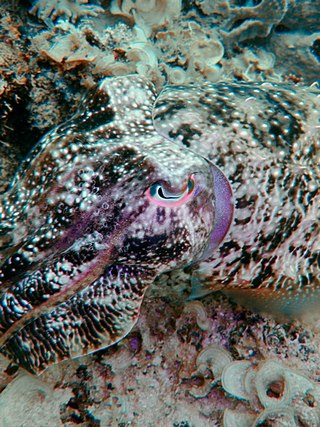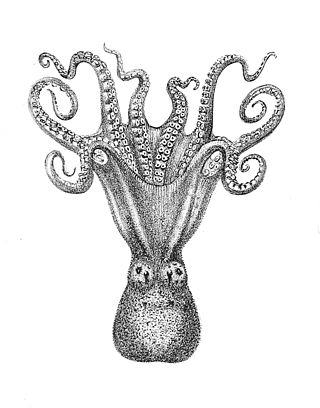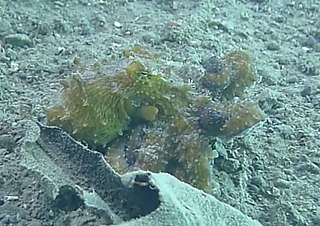
Enteroctopus is an octopus genus whose members are sometimes known as giant octopuses.

Octopus is the largest genus of octopuses, comprising more than 100 species. These species are widespread throughout the world's oceans. Many species formerly placed in the genus Octopus are now assigned to other genera within the family. The octopus has 8 arms, averaging 20 cm (8 in) long for an adult.

Sepia latimanus, also known as the broadclub cuttlefish, is widely distributed from the Andaman Sea, east to Fiji, and south to northern Australia. It is the most common cuttlefish species on coral reefs, living at a depth of up to 30 m.

Xipholeptos is a genus of squid in the family Idiosepiidae. It is monotypic, being represented by the single species Xipholeptos notoides, commonly known as the southern pygmy squid. The species was originally classified as Idiosepius notoides. The southern pygmy squid is native to the southwestern Pacific Ocean, off southern and eastern Australia. It inhabits shallow, inshore waters. It has been recorded off the coasts of New South Wales, South Australia, Tasmania and Victoria.
Abdopus is a genus of octopuses in the family Octopodidae.

Amphioctopus is a genus of octopuses comprising around 16 species.

Octopus tetricus, the gloomy octopus or the common Sydney octopus, is a species of octopus from the subtropical waters of eastern Australia and New Zealand. O.tetricus belongs to the Octopus vulgaris species group and is a commercially prized species. All species within the O. vulgaris group are similar in morphology. The English translation of O. tetricus (Latin) is 'the gloomy octopus'.
Sepia braggi, the slender cuttlefish, is a species of cuttlefish native to the Indo-Pacific Ocean. It has been found in coastal waters of southern Australia. This species was first collected in South Australia by its namesake, William Lawrence Bragg. Sepia braggi was then described by Sir Joseph Cooke Verco in 1907.Sepia braggi is part of the subgenus Doratosepion which contains to 41 species of cuttlefish in total.

Neorossia caroli, the Carol bobtail squid, is a species of bobtail squid belonging to the family Sepiolidae.
Paroctopus is a small genus of octopuses from the family Octopodidae.

Sepioloidea lineolata or more commonly known as the striped pyjama squid or the striped dumpling squid is a type of bottletail squid that inhabits the Indo-Pacific Oceans of Australia. Although traditionally falling within Sepiida, the cuttlefish order, it lacks a cuttlebone. More recent phylogenomic evidence suggests bottletail and bobtail squid may form their own order, Sepiolida. The striped pyjama squid lives on the seafloor and is both venomous and poisonous. When fully mature, a striped pyjama squid will only be about 7 to 8 centimetres in length. Baby striped pyjama squid can be smaller than 10 millimetres (0.39 in).
Callistoctopus bunurong, the southern white-spot octopus, is a species of octopus in the family Octopodidae, that can be found in Australia waters at depths of 1 to 130 meters on sandy substrates. It was originally placed in the genus Octopus, having the scientific name Octopus bunurong, but has been moved to the genus Callistoctopus.
Octopus oliveri, is a species of octopus found in the western Pacific Ocean off the coast of Japan, Hawaii, and Kermadec Island, in reefs and boulder coasts.

Octopus insularis is a species of octopus described in 2008 from individuals found off the coast of Brazil, with a potentially much larger range.

Octopus californicus is an octopus in the family Octopodidae. It is provisionally assigned to the genus Octopus, but some scholars have concluded it belongs in other genera. O. californicus was first documented by S. Stillman Berry in 1911.

Octopus australis is a species of octopus. It gets the common name hammer octopus from a modified arm possessed by males and used in reproduction. It was first described by William Evans Hoyle in 1885, based on a specimen found in Port Jackson in New South Wales.

Octopus conispadiceus is a species of long-ligula octopus, provisionally placed in the genus Octopus. It was first described by Madoka Sasaki in 1917 based on specimens bought at a fish market in Sapporo, Japan.

Octopus vitiensis, or the bighead octopus, is a species of octopus provisionally placed in the genus Octopus. It was described by William Evans Hoyle in 1885 based on a specimen found in reefs in Kandavu, Fiji during a voyage of HMS Challenger.

Abdopus abaculus, or the mosaic octopus, is a species of pygmy octopus. It was first described as Octopus abaculus by M. D. Norman and M. J. Sweeney in 1997 based on specimens caught in Zamboanga del Norte, Philippines.

Callistoctopus rapanui, or the rapanui octopus, is the only endemic octopus species in Rapa Nui. It was first described by Gilbert L. Voss in 1979 as Octopus rapanui.















